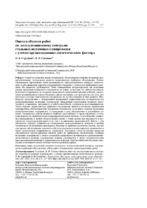| dc.contributor.author | Strutsky, N. V. | |
| dc.contributor.author | Romaniuk, V. N. | |
| dc.coverage.spatial | Минск | ru |
| dc.date.accessioned | 2024-04-12T08:29:14Z | |
| dc.date.available | 2024-04-12T08:29:14Z | |
| dc.date.issued | 2024 | |
| dc.identifier.citation | Strutsky, N. V. Оценка объемов работ по эксплуатационному контролю стальных подземных газопроводов с учетом организационно-логистического фактора = Assessment of the Scope of Work for Operational Control of Steel Underground Gas Pipelines, Taking Into Account the Organizational and Logistical Factor / N. V. Strutsky, V. N. Romaniuk // Известия высших учебных заведений и энергетических объединений СНГ. Энергетика. – 2024. – № 2. – С. 137-151. | ru |
| dc.identifier.uri | https://rep.bntu.by/handle/data/141839 | |
| dc.description.abstract | Одним из основных видов технического обслуживания стальных подземных рас
пределительных газопроводов является периодическое приборное обследование. Данное обследование представляет собой разновидность эксплуатационного контроля, включающего в себя выявление дефектов изоляционного покрытия и утечек газа приборными методами, без вскрытия трубопровода. Этим одновременно контролируются два различных уровня нарушения исправности газопровода, на одном из которых его работоспособность полностью сохраняется, но создается возможность наступления цепочки событий, угрожающих возникновением отказа в будущем (дефект изоляции), а на другом отказ, по сути, уже произошел (потеря герметичности газопровода), но до обследования не был выявлен. Приборному обследованию с определенной нормативной периодичностью подвергаются все распределительные подземные газопроводы. Выявленные повреждения подлежат обязательному устранению, исправность и работоспособность газопровода восстанавливаются. Таким образом, периодическое приборное обследование является ключевым техническим мероприятием, обеспечивающим управление техническим состоянием стальных подземных распределительных газопроводов. А проводимые в ходе обследования и дальнейшего ремонта газопроводов работы являются наиболее масштабными и трудозатратными из всех выполняемых на линейной части газораспределительной системы. Соответственно адекватное планирование в данной области весьма важно с точки зрения как надежности и безопасности газораспределительной сети, так и хозяйственно-экономической. Вместе с тем обеспечить искомую адекватность планирования эксплуатационного контроля и вообще технического обслуживания инженерных объектов на практике достаточно сложно, так как сам процесс обслуживания сочетает в себе регулируемую и нерегулируемую компоненты и имеет значительную инерционность управления. Настоящая статья посвящена вопросам обоснованного прогнозирования объемов работ по приборному обследованию стальных подземных газопроводов с учетом специально выделяемого комплексного организационно-логистического фактора, отражающего влияние сложившейся в сфере газораспределения производственной практики и управленческих подходов. Прогноз выполнен на основе актуальных в настоящий момент методов анализа временных рядов. | ru |
| dc.language.iso | ru | ru |
| dc.publisher | БНТУ | ru |
| dc.title | Оценка объемов работ по эксплуатационному контролю стальных подземных газопроводов с учетом организационно-логистического фактора | ru |
| dc.title.alternative | Assessment of the Scope of Work for Operational Control of Steel Underground Gas Pipelines, Taking Into Account the Organizational and Logistical Factor | ru |
| dc.type | Article | ru |
| dc.identifier.doi | 10.21122/1029-7448-2024-67-2-137-151 | |
| local.description.annotation | One of the main types of maintenance of steel underground gas distribution pipelines is periodic instrument inspection. This inspection is a kind of operational control, which includes detection of defects of insulation coating and gas leaks by instrumental methods, without opening the pipeline. This simultaneously controls two different levels of failure of the gas pipeline’s serviceability, one of which fully preserves its operability, but creates the possibility of a chain of events threatening to cause a failure in the future (insulation defect), while the other level of failure is, in fact, the case when the failure has already occurred (loss of tightness of the gas pipeline), but before the examination was not detected. All underground gas distribution pipelines are subjected to an instrument inspection with a certain regulatory frequency. The identified damages are subject to mandatory elimination, the serviceability and operability of the gas pipeline are being restored. Thus, periodic instrument inspection is a key technical measure that ensures the management of the technical condition of steel underground gas distribution pipelines. It should be mentioned that the work carried out during the inspection and further repair of gas pipelines is the most extensive and labor-consuming of all those performed on the linear part of the gas distribution system. Accordingly, adequate planning in this area is very important from the point of view of both the reliability and safety of the gas distribution network and the economic and economic one. At the same time, it is quite difficult to ensure the required adequacy of operational control planning and maintenance of engineering facilities in practice, since the maintenance process itself combines regulated and unregulated components and has significant inertia of management. The present article is devoted to the issues of reasonable forecasting of the scope of work on the instrument inspection of steel underground gas pipelines, taking into account a specially identified complex organizational and logistical factor reflecting the influence of existing production practices and management approaches in the field of gas distribution. The forecast is based on the currently relevant time series analysis methods. | ru |

